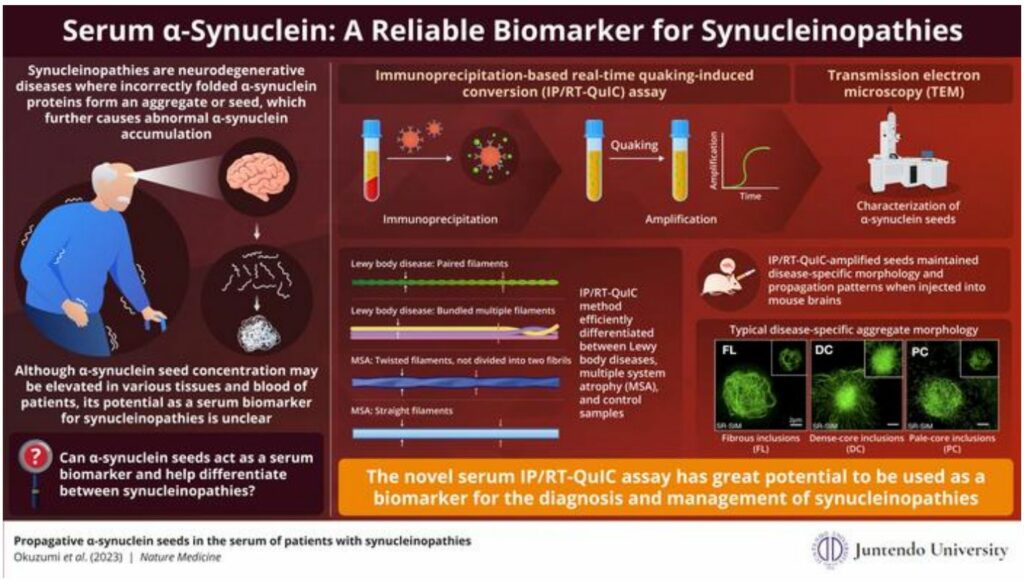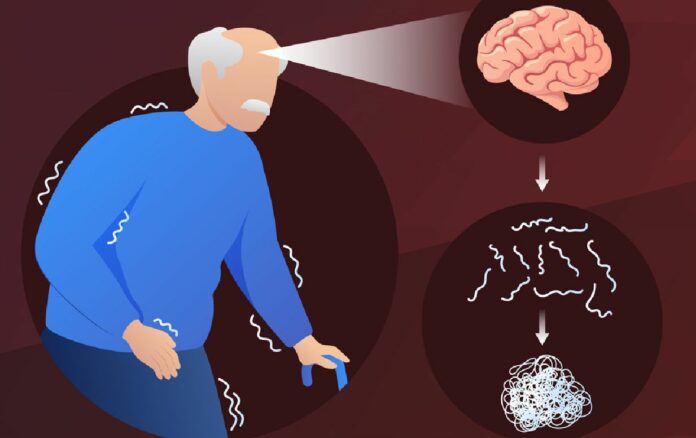Fast and Accurate Diagnosis of Neurodegenerative Diseases Now Possible with New Assay
Researchers have successfully developed a new test that can accurately identify distinct neurodegenerative disorders through the detection of abnormal α-synuclein in the blood serum of patients.
Synucleinopathies refer to a collection of neurodegenerative disorders characterized by the abnormal buildup of α-synuclein, a protein typically present in the brain and neurons. When α-synuclein folds incorrectly, it forms “seeds” that attract more α-synuclein proteins, leading to the formation of larger clumps. While these seeds have been discovered in various tissues and blood samples of individuals with synucleinopathies, their potential as biomarkers remains uncertain.
A recent study published in Nature Medicine introduces a groundbreaking assay that efficiently detects α-synuclein seeds in a patient’s serum.
The research was conducted by Associate Professor Ayami Okuzumi and Senior Associate Professor Taku Hatano from Juntendo University School of Medicine, Senior Assistant Professor Gen Matsumoto from Nagasaki University School of Medicine, and Professor Nobutaka Hattori from Juntendo University Faculty of Medicine/RIKEN Center for Brain Science.
An Innovative Serum Test for Detecting Neurodegenerative Disorders
The newly developed technique, known as immunoprecipitation-based real-time quaking-induced conversion (IP/RT-QuIC), involves the isolation of α-synuclein seeds from the patient’s serum through immunoprecipitation. This process utilizes an antibody specifically designed to bind to the target protein, allowing for its separation. The isolated seeds are then subjected to rapid amplification through real-time quaking-induced conversion, which involves vigorous shaking. The IP/RT-QuIC method boasts high sensitivity, capable of detecting serum α-synuclein seed concentrations as low as 1000pg/ml. This breakthrough is particularly significant as most existing diagnostic approaches rely on cerebrospinal fluid for synuclein detection.
The study, which became available on May 30, 2023, provides promising insights into the detection and potential diagnosis of synucleinopathies. By offering a more accessible and sensitive method for detecting α-synuclein seeds in a patient’s serum, the IP/RT-QuIC assay holds great promise for advancing our understanding and management of these debilitating neurodegenerative diseases.
“In this study, we validated the usefulness of our novel assay system, IP/RT-QuIC, as a diagnostic marker of synucleinopathies. We propose that the fibril morphology of serum α-synuclein seeds and aggregates derived by IP/RT-QuIC can discriminate between Parkinson’s disease (PD), dementia with Lewy bodies (DLB), and multiple system atrophy (MSA),” add the authors.

The research team conducted a study to assess the effectiveness of IP/RT-QuIC in detecting α-synuclein seeds in patients with neurodegenerative diseases and distinguishing them from individuals without degenerative diseases (controls). They found that IP/RT-QuIC efficiently detected these seeds in patients and could accurately differentiate between the two groups. Additionally, the team investigated the structural characteristics of the amplified seeds using transmission electron microscopy (TEM). Their observations revealed that the synuclein seed structure varied depending on the type of synucleinopathy. Paired filaments were observed in seeds from individuals with Parkinson’s disease (PD) and dementia with Lewy bodies (DLB), while multiple distinct structures, namely twisted and straight filaments, were found in seeds from individuals with multiple system atrophy (MSA). These findings provided further confirmation that IP/RT-QuIC, when coupled with TEM, has the ability to differentiate between synucleinopathies based on the specific structural features of the seeds associated with each disease.
Furthermore, the researchers conducted experiments to assess the behavior of the amplified seeds in vitro and in vivo. In vitro, they transduced the seeds into a human cell line called HEK293T, which stably expressed GFP-fused human α-synuclein with a p.A53T mutation. The seeds retained their capacity to form aggregates within the cells. Similarly, when the seeds were injected into the brains of mice, they maintained their ability to form disease-specific aggregates. Importantly, the aggregates displayed distinct morphologies depending on the type of synucleinopathy. These findings indicate that IP/RT-QuIC can diagnose specific synucleinopathies by analyzing the structural differences of the α-synuclein seeds and their aggregates, both in vitro and in vivo.
“At present, a neurologist’s consultation is necessary to diagnose synucleinopathies. However, using IP/RTQuIC, a general internist can make the diagnosis. Therefore, more patients with synucleinopathies may be diagnosed with precision and could receive appropriate treatment at an earlier stage,” point out the authors.
“Our new IP/RT-QuIC assay may have many future applications as a biomarker for precise diagnosis and monitoring of treatment of neurodegenerative diseases in clinical trials. This simple diagnostic method will enable establishment of personalized therapy options for synucleinopathies.”
Image Credit: Professor Hattori and his team from Juntendo University School of Medicine
